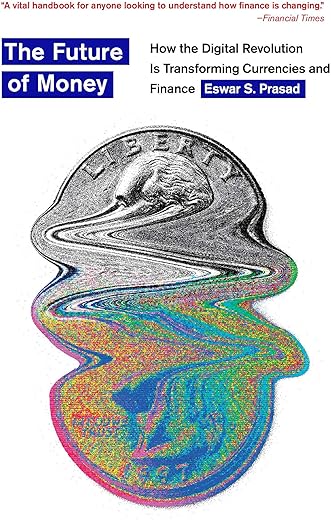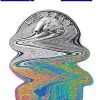The Future of Money: How the Digital Revolution Is Transforming Currencies and Finance
£16.10£19.00 (-15%)
An Economist Book of the Year
A Financial Times Book of the Year
A Foreign Affairs Book of the Year
A ProMarket Book of the Year
One of The Week’s Ten Best Business Books of the Year
“A road map for money managers, market strategists, and others seeking to understand this new world.”―Barron’s
“Money shapes economies, economies shape nations, nations shape history. It follows that the future of money is profoundly important. Here is a definitive report on where we are and where we are going.”―Lawrence H. Summers, former Secretary of the Treasury
“Prasad manages to make the financial system intelligible and interesting without resorting to shortcuts and exaggeration…Previous overhauls mainly improved existing systems, he notes. The end of cash―likely within a decade or two―is revolutionary.”―The Economist
The world of finance is on the cusp of a major disruption that will affect corporations, bankers, states―indeed, all of us. As Eswar Prasad makes clear, the end of physical cash will fundamentally rewrite how we live. Bitcoin, Ethereum, and other cryptocurrencies are just the beginning: spurred by their emergence, central banks will increasingly develop their own, more stable digital currencies. Meanwhile, cryptocurrencies themselves will evolve dramatically as global corporations like Meta, Apple, and Amazon join the game.
Prasad shows how these innovations will redefine the very concept of money, unbundling its traditional functions. This transformation promises greater efficiency and flexibility, but also carries the risk of instability, lack of accountability, and erosion of privacy. A lucid, visionary work, The Future of Money shows how to maximize the best and guard against the worst of what is to come.
Read more
Additional information
| Publisher | Belknap Press (27 Oct. 2023) |
|---|---|
| Language | English |
| Paperback | 496 pages |
| ISBN-10 | 0674293894 |
| ISBN-13 | 978-0674293892 |
| Dimensions | 15.75 x 3.81 x 23.5 cm |










by Serghiou Const
The book is authoritative, comprehensive, and balanced in its treatment while its writing combines unimpeded flow, wit and clarity.
If in view of the above, the reader assumes that the book is an easy read that would be wrong. The book is intrinsically, conceptually difficult, and suitable for the serious reader who, however, would be deeply rewarded.
The book deals with the transformation of currencies and finance effected by the digital revolution.
The book commences with basic concepts:
Money serves three basic functions namely as a unit of account, a medium of exchange, and a store of value. Fiat money is created by an official authority and is usually not backed by anything other than faith in the central bank or the government that stands behind it. Fiat money constitutes legal tender, which means that it must, by law, be accepted for settling any debt obligation to a private party.
The key functions of a financial system essentially comprise to providing products for saving and credit and managing risk; financial intermediation is the process of matching the funds provided by savers with the needs of borrowers.
The task of intermediating savings into investment and thus allocating this capital optimally is accomplished through a variety of financial institutions and markets which also include stock markets and bond markets.
Banks serve a crucial function by bundling short term deposits and then matching them with financing of long-term projects that increase an economy’s output and employment.
Payment systems are the arteries that carry the lifeblood of finance. Payments between households and businesses and within these two groups, underpin transactions involving goods, services, and assets. Systems that efficiently transfer money across financial institutions, either within or between countries are also essential to the operation of a financial system. Payment systems ( a term that encompasses systems that enable payments to be initiated, cleared and settled ) are thus a key a key part to the financial infrastructure.
Payment systems can be classified broadly into three categories: retail, wholesale ( interbank ) and cross-border.
To improve communications related to cross-border transactions, major banks from a number of countries set up the Society of Worldwide Interbank Telecommunications ( SWIFT ) in 1973 to develop a common protocol for payment messages.
The timing of the Fintech wave might be the result of the fortuitous confluence of factors – a wave of technological advancements, including in mobile and internet – related technologies; a laxer financial regulation; and low interest rates that sparked the search of new sources of profit and lower costs in financial markets, collectively improving the execution of the basic functions of a financial system that is credit, services and insurance. The biggest impact is likely to be on payment systems.
A common theme that link new entrants in Fintech is their use of digital technologies and their largely online existence. Another theme is the use of big data ( analysis of big data obtained from different sources ), machine learning and artificial intelligence tools to automate the application, screening, and approval processes involved in the provision of credit, insurance, and other financial products.
Mobile money – One innovation that has taken root and began to modernize finance in developing countries is modest in terms of technology but transformative in its effects on people’s lives -the advent of mobile-based apps designed to facilitate the use of money and banking.
While mobile money takes existing technologies and puts them to transformative uses, the latest wave of Fintech is more often characterized by new technologies some of which are in themselves transformative.
Fintech firms are making forays into areas varying from basic financial intermediation to insurance and payment systems. In each of these areas, new technologies are improving extant business models and sometimes also creating new financial products or ways of doing business.
Bitcoin – Cryptocurrencies such as Bitcoin are digital currencies that are not backed by any government authority ( nor, in most cases by any financial or tangible assets either ) and whose building blocks include some cryptographic tools. Bitcoin and the innovative technology underlying it, referred to as the blockchain, set off a mania for cryptocurrencies. Whatever Bitcoin’s ultimate destiny might be, it is the blockchain technology that is likely to become its enduring legacy.
Before discussing how Bitcoin works, it is worth reviewing the key characteristics of an efficient payment system. It must provide a way of identifying and connecting the parties to a transaction; facilitating and validating the actual transaction; making sure the transaction is easily verifiable and also immutable ( cannot be undone or changed later ); and precluding double-spending of the same unit of money. Each of these steps is, on its own, a big technical challenge. Yet, Bitcoin solves them all.
Public and private digital keys constitute the essential elements of anonymous digital payment systems. A digital coin is stamped with the public key of its owner; it would also be associated with the owner’s private key to ensure that it has only one owner. Thus each digital coin is identified by two attributes – a public key and the corresponding private key. To transfer the coin, the owner signs the coin ( digitally ) using their private key together with the public key of the next owner: the person to whom they are making the payment. Anyone can ( electronically ) check the public keys of both sender and recipient to verify the chain of ownership.
Sending information related to a massive volume of transactions across computer networks would, however, be slow and cumbersome.
Two mathematical concepts help transform this into a manageable problem: the first element is a cryptographic hash function. This is a mathematical function that takes a string comprising letters and numerals ( which could be a message, a number, or a combination) of arbitrary size and compresses it into another string of letters and numerals of fixed length, called a hash. The function is deterministic, meaning that it will always render the same output when the input is the same. But it is nearly impossible to back out the input from the output. For the purpose of a cryptocurrency, a hash serves as a digital fingerprint of a transaction.
The second element is a Merkle tree which is the case of having to compress information about a set of financial transactions. The corresponding Merkle tree would be built by taking hashes of individual transactions ( each of which is a ‘leaf’ on the tree ) and then repeatedly applying the hash function to pairs of hashes in a specific progression until there is only one hash. This final output, called the root hash or Merkle root, produces a unique digital fingerprint of the entire set of transactions.
To sum up, the blockchain is a publicly shared ledger of transactions maintained on a decentralized network of computer nodes. Blocks of validated transactions are added to the blockchain through computations performed by individual miners. The consensus mechanism for validated transactions is, thus, decentralized and the blockchain is buttressed by the transparency and the decentralized structure of the network which makes it largely tamperproof. Bitcoin’s trustworthiness is aided by the ease of verification of transactions. The system is designed to protect the integrity of the currency without the need of transactions to pass through banks and other third party intermediaries.
I shall conclude the review with the case for issuing Central Bank Digital Currencies ( CBDCs ).
A CBDC has a number of possible benefits, some of which depend on its particular design. First, a CBDC provides greater transactional efficiency than cash, making payments cheaper and quicker. Second, it can serve as a backstop to private sector managed payment systems, avoiding a breakdown of the payment infrastructure during a crisis of confidence. Third, it helps increase financial inclusion, providing low-income households and those in sparsely populated areas easy access to digital payment as well as other financial products and services. Fourth, it has the potential to ease the zero lower bound constraint on monetary policy and also make easier to engineer helicopter drops of central bank money ( without relying won fiscal transfers ). Fifth, it brings informal economic activity out of the shadows, thereby broadening the tax base and reducing tax evasion, which adds up to higher tax revenues for the government. Sixth, its traceability makes it harder to use CBDC for illicit purposes such as laundering of money and financial terrorism.
by Mr David Johnson
Excellent book for a reasonably intelligent lay person. Recommended.
by sideword
I stand by the title. It is informative and important. However, the read is not as smooth as it should be. The diction is a little rocky. Still I would recommend this and anyone who wants to know what’s coming, this is definitely required reading.